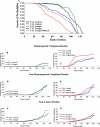The antioxidant tempol reduces carcinogenesis and enhances survival in mice when administered after nonlethal total body radiation
- PMID: 22805306
- PMCID: PMC3445749
- DOI: 10.1158/0008-5472.CAN-12-1879
The antioxidant tempol reduces carcinogenesis and enhances survival in mice when administered after nonlethal total body radiation
Abstract
There is significant interest in the development of agents that can ameliorate radiation damage after exposure to radiation has occurred. Here we report that chronic supplementation of the antioxidant Tempol in the diet of mice can reduce body weight without toxicity, decrease cancer, and extend survival when administered after nonlethal total body radiation (TBI). These effects were apparent in two different strains of mice (C3H, CBA) exposed to TBI (3 Gy). Notably, delaying administration of the Tempol diet one month after TBI could also enhance survival. Tempol reduced the incidence of hematopoietic neoplasms (lymphomas) in both strains, whereas both the onset and incidence of nonhematopoietic neoplasms were reduced in CBA mice. These results encourage further study of Tempol as a chemopreventive, to reduce the incidence of radiation-induced second malignancies after a course of definitive radiation therapy. Tempol may also find applications to reduce the risk of cancers in populations exposed to nonlethal radiation due to nuclear accidents or terrorist attacks.
Figures




References
-
- Stone HB, Coleman CN, Anscher MS, McBride WH. Effects of radiation on normal tissue: consequences and mechanisms. Lancet Oncol. 2003;4:529–36. - PubMed
-
- Kohn HI, Fry RJ. Radiation carcinogenesis. N Engl J Med. 1984;310:504–11. - PubMed
-
- Stone HB, Moulder JE, Coleman CN, et al. Models for evaluating agents intended for the prophylaxis, mitigation and treatment of radiation injuries. Report of an NCI Workshop, December 3-4, 2003. Radiat Res. 2004;162:711–28. - PubMed
Publication types
MeSH terms
Substances
Grants and funding
LinkOut - more resources
Full Text Sources
Other Literature Sources
Medical
Molecular Biology Databases

